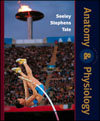 |  Houston CC: Anatomy & Physiology , 6/e Rod Seeley,
Idaho State University
Trent Stephens,
Idaho State University
Philip Tate,
Phoenix College
Book FeaturesThis text uses a comprehensive pedagogical system to help students master the facts and concepts of anatomy and physiology. The text discussion is presented within a supporting framework of learning aids that help organize studying, reinforce learning, and promote problem-solving skills. This approach is followed by a carefully devised set of learning aids at the end of each chapter, designed to helps students review the chapter content, evaluate their grasp of key concepts, and utilize what they have learned. The following features comprise the Anatomy and Physiology pedagogical system:Chapter Introduction
Each chapter opens with a thought-provoking vignette that ties in with the chapter topic. The final paragraph of the introduction gives a quick rundown of the major section divisions of the chapter.
Section Objectives
A brief list of objectives at the beginning of each section introduces the key concepts students should understand after reading each section.
Section Review
Review questions at the end of each major section prompt students to test their understanding of key concepts. These self-tests help students determine whether they have a sufficient grasp of the information before proceeding to the next section.
Predict Questions
These innovative critical thinking exercises encourage students to become active learners as they read by challenging students to use their understanding of new concepts to solve a problem. Answers to Predict questions are given at the end of each chapter, allowing students to evaluate their responses and discover the logic used to arrive at the correct answer.
Vocabulary Aids
Key terms are set in boldface where they are defined in the chapter, and most terms are included in the glossary at the end of the book. Pronunciation guides are included for difficult words. Because knowing the original meaning of a term can enhance understanding and retention, derivations of key words are given when they are relevant. Furthermore, a handy list of prefixes, suffixes, and combining forms is printed on the inside back cover as a quick reference to identify commonly used word roots.
Chapter Summary
The page-referenced summary outline briefly states the important facts and concepts covered in each chapter to provide a convenient “big picture” of the chapter content.
Review and Comprehension
These multiple-choice practice questions cover all of the main points presented in the chapter. To help students gauge their mastery of the material. Answers are given in Appendix F.
Critical Thinking
These innovative exercises encourage students to apply chapter concepts to solve a problem. Answering these questions helps build a working knowledge of anatomy and physiology while developing reasoning skills. Answers are given in Appendix G.
In addition to the pedagogical framework within the narrative of the text, this book utilizes a highly instructional art program that offers a number of specialized features:Process Figures
Process Figures organize the key occurrences of physiological processes into a series of small steps. Sequence indicators within each Process Figure correspond to the numbered steps along the side, allowing students to zero in on the site where the action described in each step takes place.
Homeostasis Figures
Homeostasis Figures are specialized flow charts that diagram the mechanisms body systems employ to maintain homeostasis. The normal range for a given value is represented by the graphs in the center of each figure, and the arrows lead the student to the various sequences of each mechanism.
Color Consistency
The colors used to represent different anatomical structures have been applied consistently throughout the book. This reliable pattern of color consistency helps students easily identify the structures in every figure and promotes continuity between figures.
Varying Viewpoints
Illustrations depicting complex structures or processes combine macroscopic and microscopic views to help students see the relationships between increasingly detailed drawings.
Reference diagrams are provided as needed to orient the reader to the view or plane an illustration represents.
Dynamic Photographs
Photographs of dissected cadavers and bones, as well as histology photomicrographs and surface anatomy photos, are presented in conjunction with the artwork to provide a glimpse of what actual structures look like in comparison with their illustrated counterparts. Anatomy and Physiology also provides a wealth of clinical examples to illustrate the application of basic knowledge, promote interest, and demonstrate relevance. This information is presented throughout the book in the following features:Clinical Topics
Interesting clinical sidebars reinforce or expand upon the facts and concepts discussed within the narrative, demonstrating how concept knowledge translates to applications in a clinical setting.
Clinical Focus
These in-depth boxed essays explore relevant topics of clinical interest. Subjects covered include pathologies, current research, sports medicine, exercise physiology, pharmacology, and clinical applications.
Systems Pathology
These boxes explore a specific disorder or condition related to a particular body system. Presented in a modified case study format, each Systems Pathology box begins with a patient history followed by background information about the featured topic. Every Systems Pathology box includes a Predict question specific to the case study and a System Interactions table that summarizes how the condition profiled impacts each body system. |
|



 2003 McGraw-Hill Higher Education
2003 McGraw-Hill Higher Education

 2003 McGraw-Hill Higher Education
2003 McGraw-Hill Higher Education